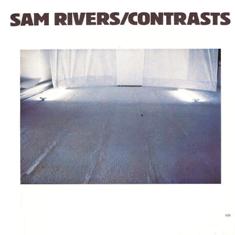
Sam Rivers
Contrasts
ECM CD / LP / download ****
Issued on CD for the first time this quartet album recorded at the Tonstudio Bauer studio, Ludwigsburg, in December 1979, finds the avant gardist ex-Miles Davis player and loft scene avatar Sam Rivers (1923-2011) on saxes and flute, with George Lewis, trombone, Dave Holland, double bass, and Thurman Barker, drums and marimba. There are seven tracks, mostly quite short, all Rivers' compositions, free form but with strong inferred or discernible structures, with ‘Dazzle’ the longest clocking in at some nine minutes and 16 seconds.
Rivers’ time with ECM was brief but goes back to 1972 and an appearance on Holland’s classic album Conference of the Birds yet Contrasts is more indicative of his own approach and apart from this album you’ll have to return to Rivers’ 1960s period on Blue Note to find landmark material of his, especially 1964’s Fuchsia Swing Song.
It’s Lewis who begins Contrasts joined on ‘Circles’ in an abstract clash of tonalities by Rivers the pair telling a story by way of what can be imagined as diagonal improvising lines Barker’s multi-directional drumming approach providing the open situation needed while Holland’s chromaticism adds texture rather than pulse.
‘Zip’ has a bluesy Ornettian energy, Rivers taking up the running on tenor and Barker tap tapping like Ed Blackwell appropriately. ‘Solace’ has an almost unbearably tender aspect to it, the marimba textures and Holland’s very slow tonal movement props to the Shorter-esque soprano main narrative by Rivers. Lewis finds ways of curling into the group interplay but this is one of the contrasts you might be looking for on a record that values sharp juxtapositions in terms of timbre, tone, and interplay.
‘Verve’ has Rivers on flute and it has a Caribbean flavour Holland pulsing ever more urgently and Barker coming into his own on kit. The long ‘Dazzle’ has a different rhythmic fast scampering drum pattern at the beginning and Rivers opens up before what could have been a straight run through is diverted by Lewis with a metre that cuts across the obvious flow and delivers the tune into another space.
‘Images’ with the input of the marimba at the beginning has an air of mystery to it while ‘Lines’ returns to the post-Ornettian landscape that is the bedrock sound of Rivers’ approach reaching way beyond the bar-line.
It’s a pity the album didn’t made it on to CD during Rivers’ life time. Yet there's no denying it’s one of the big highlights of the latest raft of reissue rarities by ECM. SG